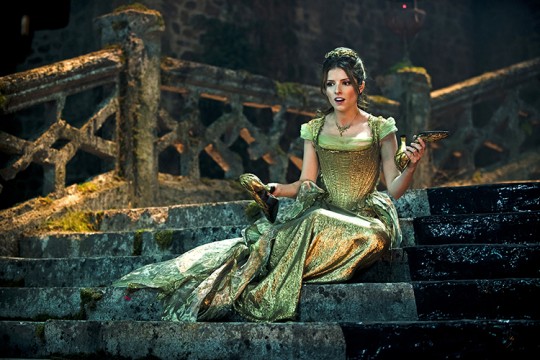
Anna Kendrick plays Cinderella in Disney’s ‘Into the Woods.’ The movie opened Christmas Day.
Credit: Courtesy of Walt Disney Studios.
When the Academy Award nominations were announced earlier this month, many filmmakers and actors possibly felt either surprised or snubbed to see which of them would be walking down the red carpet in Hollywood on Feb. 22. One film whose backers might have feared a lack of acknowledgment from the Academy is “Into the Woods,” Disney’s adaptation of the hit Stephen Sondheim Broadway musical. While the film boasts an impressive cast and an Oscar-nominated director in Rob Marshall (for 2002’s “Chicago”), the live-action musical has not done well at the Oscars lately.
The silver screen once shimmered with an aural spectacle — it was a time when the “triple threat” was the most coveted muse of the motion picture. Between 1929 and 1968, there were nine live-action “Best Picture” winners. Since that time, only “Chicago” has taken home the top prize. “Into the Woods” (three nominations total) joins 2012’s “Les Miserables” (eight nominations) as only two musicals since “Chicago” to be nominated for the coveted golden statue. However, if the movie wants to buck the trend of musicals being left out, having Meryl Streep in a starring role and a Oscar-winning director in Marshall isn’t a bad formula.
The film, adapted from the classic 1980s Broadway musical, tells the story of a Baker and his wife, who must find four special ingredients for a Witch’s potion in order to conceive a child. The story also includes a number of recognizable tall tales including “Red Riding Hood,” “Jack and the Beanstalk,” “Cinderella” and “Rapunzel.” After being in development for more than a decade, the film was given a relatively modest $50 million budget. The musical’s book writer, James Lapine, a Mansfield, Ohio, native, wrote the film’s screenplay, while Sondheim returned to write a new song for the film that was ultimately cut.
The musical features a cast including Anna Kendrick, Emily Blunt, James Corden, Chris Pine, Johnny Depp, as well as Streep, who received her 19th Oscar nomination for her role as The Witch.
In a December conference call with college media, Kendrick and Pine talked about their experience with the film.
Q: What was this experience like for the both of you?
Chris Pine: It was totally different from what I’ve done before. The musical-theater genre is very specific. I had a lot of fun learning the ins and outs of the technique of the genre.
Anna Kendrick: It was harder (than shooting “Pitch Perfect”) — a lot harder. We’re singing pop music in “Pitch Perfect” and we’re singing songtime in this. I was petrified and excited. It was such a challenge but obviously singing songtime is so rewarding.
Q: What was the advantage of working with such a strong cast and crew?
CP: Rob really set the tone in the beginning. He’s a director that comes from the theater world, so he recognized the importance of having a month of rehearsal before you ever show your wears to the public. He made sure to build that in.
Q: How did each of you take these roles and make them your own?
CP: Everyone in this film really goes through these wonderfully complex journeys and they experience joy and heartache and sorrow and grief. My role of the prince is way more two-dimensional than that. He’s a wonderfully self-absorbed character and I had a lot of fun bringing some levity to the picture, or at least I tried to, and there’s a bit of a buffoon in the prince, and I had a lot of fun making him buffoonish.
AK: I had a lot of fun watching Chris being a buffoon. The great thing was that Rob really embraced a modern sensibility for these characters — because these stories kind of belong to the ages, it makes sense in a way that we update them for each generation. And one thing he allowed me to do was be an overthinking, neurotic princess and I think modern women have a tendency to overthink everything and they don’t trust their gut.
Q: What do you think this story and format brings to different generations?
AK: It’s based on stories that parents have told their children for generations, so there’s the element where it’s pure fantasy and it’s exciting for kids and there’s an element which is specifically centered towards parents which is what we tell our children. Children take lessons to heart and it’s about that they’re listening to us even if it doesn’t feel that way, and it’s really our responsibility to prepare them for the responsibilities of the world.


